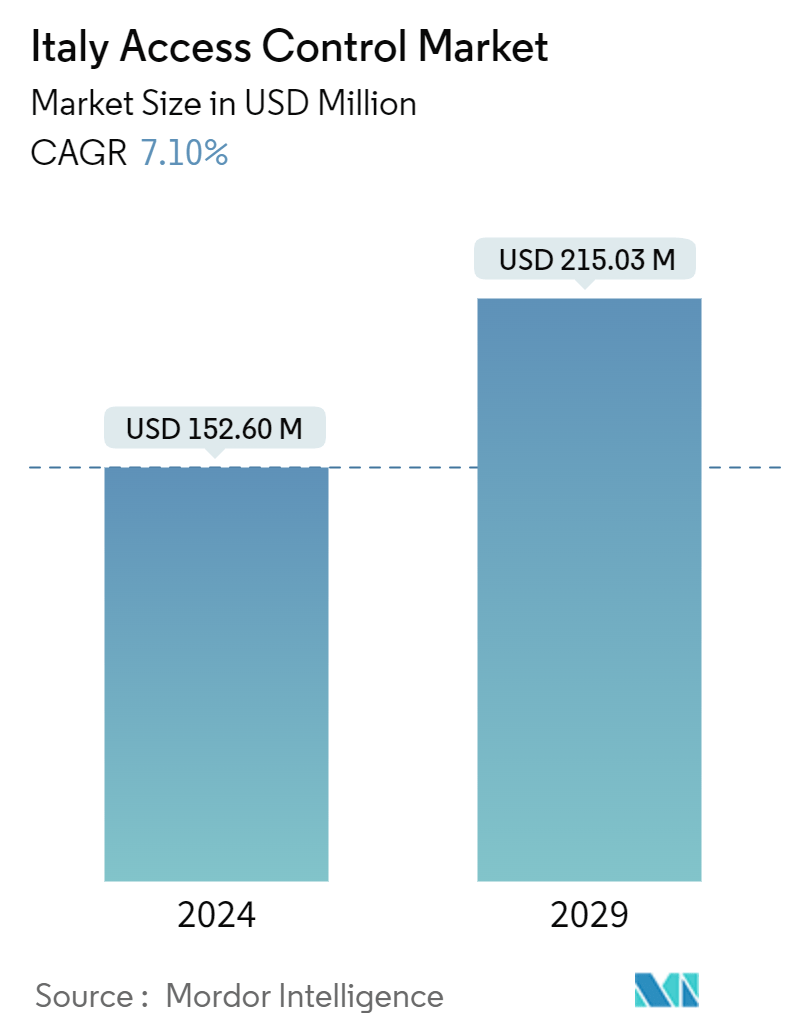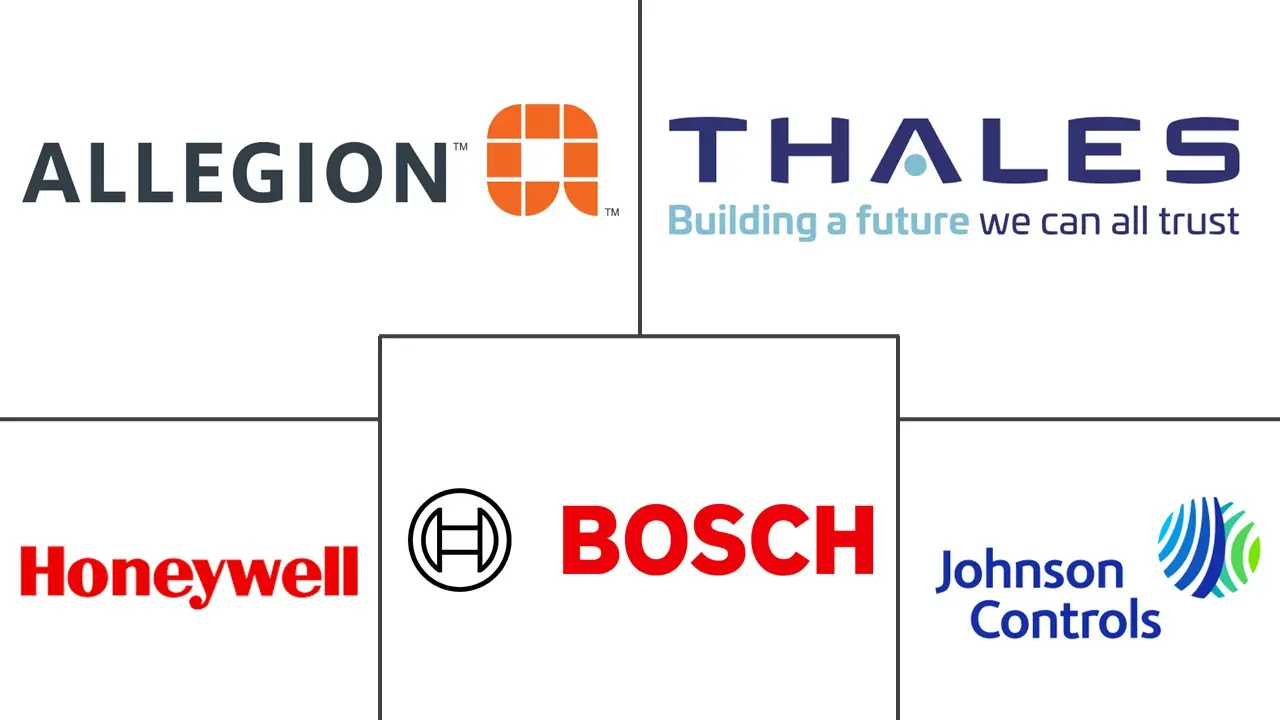Market Size of Italy Access Control Industry

| Study Period | 2018 - 2029 |
| Base Year For Estimation | 2023 |
| Market Size (2024) | USD 152.60 Million |
| Market Size (2029) | USD 215.03 Million |
| CAGR (2024 - 2029) | 7.10 % |
| Market Concentration | Medium |
Major Players
*Disclaimer: Major Players sorted in no particular order |
Italy Access Control Market Analysis
The Italy Access Control Market size is estimated at USD 152.60 million in 2024, and is expected to reach USD 215.03 million by 2029, growing at a CAGR of 7.10% during the forecast period (2024-2029).
- Access control devices are components that are used in access control systems to enforce rules and regulations regarding the entry and exit of individuals. These devices play an important role in maintaining the security and integrity of a premises or system. Locks are fundamental devices in access control systems as they control the physical security of entrances.
- Card readers are devices that read access cards or key fobs to grant or deny access to individuals. These devices are often used in conjunction with authentication methods such as passwords or biometric analysis. Biometric devices use unique physical or behavioral characteristics, like facial recognition or fingerprints, to verify the identity of individuals and grant access.
- The Internet of Things (IoT) has increased the efficiency and standard of automation systems by enabling secure data exchange and tying smart objects to the Internet. Remote monitoring of key areas is made possible by cloud-based communication between connected security systems and devices. Additionally, the use of password authentication to thwart hacking makes IoT-based security systems secure. Because IoT can be used in a variety of solutions, such as smart alarm systems and smart garage door openers, it is replacing many businesses' traditional processes.
- Additionally, security systems that are cloud-based and mobile are becoming a superior choice. Mobile credentials provide a more convenient and secure alternative. Since people frequently carry their mobile phones with them wherever they go, access control devices have naturally developed for this market. Mobile access control also has remote functionality. For instance, after being alerted by an apartment intercom system, a tenant can grant access to a visitor from a mobile app on their phone.
- Cloud-based access control is intuitive to use and offers the most flexibility for administrators. Access credentials can easily be granted or revoked from any device or location. User authorization, access points, and data trends are centralized in a single, remotely accessible database.
- This is a significant advancement in the physical security industry as it eliminates the need for an on-site IT professional to manage the system. Another significant benefit that has helped fuel the growing popularity of cloud access control is scalability. Facility and property managers who manage security at multiple sites can easily manage their databases from one location. From protecting the perimeter to securing high-value assets, access control systems are a fundamental responsibility for organizational security departments.
- Several market players are collaborating with each other to enhance their market share. For instance, in May 2024, Ermessrl, one of the prominent players providing solutions for the identification and security of people, signed a distribution agreement with Zwipe, a pioneer in the development of biometric technology on cards for identification, access control, and payment. According to this partnership, Ermessrl agreed to distribute Zwipe's biometric access cards in Italy. ZwipeAccess utilizes advanced biometric capture and matching technology to securely store the cardholder's encrypted fingerprint template directly within the card's smart chip during issuance.
- However, the lack of awareness about security solutions and the high prices associated with access control devices can be significant restraints to the growth of the studied market. The cost of implementing access control systems, including hardware, software, and installation, can be a barrier for some organizations, especially smaller businesses or budget-constrained entities.
- Additionally, the complexity of integrating access control devices with existing systems can pose a challenge. Organizations may need help in seamlessly integrating access control devices with their current infrastructure, leading to delays or complications in implementation.
- Also, the conflict between Russia and Ukraine will significantly impact the semiconductor industry. The conflict has already exacerbated the electronics and semiconductor supply chain issues and chip shortages that have affected the industry for some time. The disruption may result in volatile pricing for critical raw materials such as nickel, palladium, copper, titanium, and aluminum, resulting in material shortages. This, in turn, could impact the manufacturing of access control devices.
Italy Access Control Industry Segmentation
Access control devices are components that are used in access control systems to enforce rules and regulations regarding the entry and exit of individuals. For market estimation, the revenue generated from the sale of access control devices and software offered by different market players for a diverse range of applications was tracked. These market trends are evaluated by analyzing the investments made in product innovation, diversification, and expansion. Further, the advancements in the Internet of Things, artificial intelligence, machine learning, cloud computing, and cyber security are also crucial in determining the growth of the studied market.
The Italian access control market is segmented by type (card reader and access control devices, biometric readers, electronic locks, software, and other types) and end-user vertical (commercial, residential, government, industrial, transport and logistics, healthcare, military and defense, and other end-user verticals). The market sizes and forecasts are provided in terms of value (USD) for all the above segments.
| By Type | |||||
| |||||
| Biometric Readers | |||||
| Electronic Locks | |||||
| Software | |||||
| Other Types |
| By End-user Vertical | |
| Commercial | |
| Residential | |
| Government | |
| Industrial | |
| Transport and Logistics | |
| Healthcare | |
| Military and Defense | |
| Other End-user Verticals |
Italy Access Control Market Size Summary
The Italian access control market is experiencing a significant transformation driven by advancements in technology and increasing security concerns. Access control systems, which include devices such as locks, card readers, and biometric scanners, are essential for maintaining the security and integrity of premises. The integration of Internet of Things (IoT) technology has enhanced the efficiency of these systems, allowing for remote monitoring and secure data exchange. Cloud-based and mobile access control solutions are gaining popularity due to their flexibility and convenience, enabling users to manage access credentials from any location. These systems are particularly beneficial for facility managers overseeing multiple sites, as they offer centralized control and scalability. The market is characterized by collaborations among key players, such as Ermessrl and Zwipe, to enhance product offerings and expand market reach.
The demand for access control devices is being fueled by the rising need for robust security solutions across various sectors, including commercial, healthcare, and government facilities. Biometric readers, which use unique physical characteristics for authentication, are becoming increasingly common, offering a high level of security by eliminating the need for traditional access methods like cards and keys. The commercial sector in Italy is adopting electronic locks and card readers to streamline access management and enhance security. However, challenges such as high costs, lack of awareness, and integration complexities may hinder market growth. Additionally, geopolitical issues, such as the conflict between Russia and Ukraine, are impacting the semiconductor supply chain, potentially affecting the availability and pricing of access control devices. Despite these challenges, the market is poised for growth, supported by the increasing value of commercial real estate and the ongoing development of smart infrastructure projects in Italy.
Italy Access Control Market Size - Table of Contents
-
1. MARKET INSIGHTS
-
1.1 Market Overview
-
1.2 Industry Attractiveness - Porter's Five Forces Analysis
-
1.2.1 Threat of New Entrants
-
1.2.2 Bargaining Power of Buyers/Consumers
-
1.2.3 Bargaining Power of Suppliers
-
1.2.4 Threat of Substitute Products
-
1.2.5 Intensity of Competitive Rivalry
-
-
1.3 Industry Value Chain Analysis
-
-
2. MARKET SEGMENTATION
-
2.1 By Type
-
2.1.1 Card Reader and Access Control Devices
-
2.1.1.1 Card-based
-
2.1.1.2 Proximity
-
2.1.1.3 Smart Card (Contact and Contactless)
-
-
2.1.2 Biometric Readers
-
2.1.3 Electronic Locks
-
2.1.4 Software
-
2.1.5 Other Types
-
-
2.2 By End-user Vertical
-
2.2.1 Commercial
-
2.2.2 Residential
-
2.2.3 Government
-
2.2.4 Industrial
-
2.2.5 Transport and Logistics
-
2.2.6 Healthcare
-
2.2.7 Military and Defense
-
2.2.8 Other End-user Verticals
-
-
Italy Access Control Market Size FAQs
How big is the Italy Access Control Market?
The Italy Access Control Market size is expected to reach USD 152.60 million in 2024 and grow at a CAGR of 7.10% to reach USD 215.03 million by 2029.
What is the current Italy Access Control Market size?
In 2024, the Italy Access Control Market size is expected to reach USD 152.60 million.

